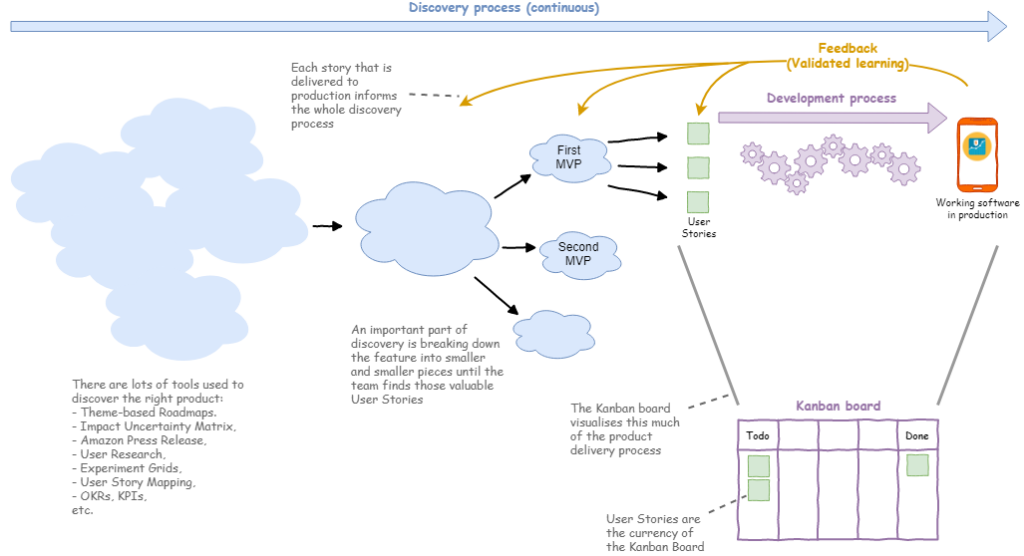Bringing together the necessary disciplines to form high-performance cross-functional teams is a key management decision when creating good software products. All software products are one-offs, unique, so having the product owner, designer, developers and testers in the same team is the most effective way to make essential trade-offs when delivering “good enough” solutions. Add to this the importance of early feedback that only comes from doing iterative releases, and an empowered cross-functional teams becomes the best vehicle for success in a highly-competitive marketplace.
True product teams do exist, but more often they are really just delivery teams, or at best feature teams. The distinction can be captured with the question: Are we giving the teams problems to solve or solutions to build? True product teams are trusted to come up with the best solutions to meet business objectives. However, lack of trust is often a big issue, but so is a lack of maturity. Product teams take time to form and usually need coaching. Management should also focus on the teams’ outcomes and allow them to do their jobs without too much interference.
One way of organising the company is to give the product discovery activities to a separate “Product Team” with the necessary competencies: POs, designers, business analysts, etc. This team should then come up with the winning product concepts for the cross-functional teams to build. This reduces the other teams to being delivery teams doing exactly what the “Product Team” decides. One side-effect of this is that there is now no room for doing experiments in the teams since the course is already plotted.
The problem with this model is that “Product Team” will have been given a purpose with the expectation to deliver something useful. There is then pressure on the team to come up with guaranteed money-spinners for the company, and they will work hard to describe a viable product solution, often using high-fidelity prototypes. This results in a large chunk of work, essentially a requirements document, even if it is in graphical format, that must be handed over to the feature/delivery teams, who must then start over, making the necessary trade-offs and reorganising the work into iterations. The delivery teams may well use Agile techniques and tools to build the solution, but it is really just operating in a big waterfall process.
The best products are built by teams that care about the products they build and the customers that use them. Naturally, they will have insights and ideas about improvements (experiments) that can be made to the product, and in a true product team this is how discovery and delivery are combined to deliver just enough software to satisfy the customers’ needs. However, in the waterfall process described above the ability of the delivery/feature team to influence the product is limited because a) the waterfall process is one-way and b) the “Product Team” see concept work as being their sole responsibility. This is a major cause of frustration for the teams and as a result there is a big risk that the most engaged team members will leave to find companies where they are allowed to make impact on the product.
The PO is a key member in a cross-functional team. If the team is a true product team then the PO will take total ownership of the product and be involved in all aspects of the product lifecycle, from concept and feature development to back-office processes and support tools, legal requirements, and more. However, in the waterfall process above, they essentially have only two roles, one is as a delivery manager in the delivery team, the other as a feature expert in the “Product Team”. Neither role covers the totality of a true Product Owner role; in fact the waterfall process is really just driving a feature factory. Of course, delivering customer value is the most important thing the team can do, but it is not the only thing, the problem is that the waterfall process does not support delivering other types of value.
In giving responsibility for these two closely interlinked processes of discovery and delivery to different teams, management is obliged to ensure that a good relationship exists between the teams to ensure success, and that the one-way waterfall process becomes instead a two-way exchange of ideas between partners. In the worst case, management are de facto prioritising feature delivery over every other type of work, ignoring the fact that different types of value exist, value which can have just as much impact on the company fortunes as feature development.
Companies already in the situation described above can try to improve it, but a sense of trust has to exist between all of the teams to do so, because changing how we work requires that we trust that the changes are for the good of the company and not only for the good of one team. This requires strong management support.

